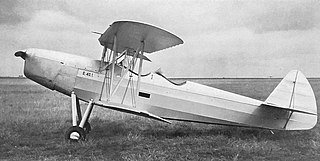
The Caproni Ca.100 was the standard trainer aircraft of the Regia Aeronautica in the 1930s. Large numbers of this tandem, two-seat, biplane were built, powered by different engines.
The Aichi AB-1 was a result of a 1926 government call for a small, Japanese-built, civil transport biplane able to operate from land or water. It won the contest in both roles but did not reach production as airlines moved from biplanes to monoplanes. Nonetheless, it remained in commercial use well into the 1930s.

The Short S.7 Mussel was a single-engined two-seat monoplane built by Short Brothers to test the performance of their duralumin monocoque floats. Two were built.
The Short S.6 Sturgeon was a prototype single-engined biplane naval reconnaissance aircraft, built to an Air Ministry specification but mostly intended as a demonstrator of the corrosion resistance of duralumin aircraft structures. Two were made.

The Praga E-40 was a single engine, two seat, biplane basic trainer, built in Czechoslovakia in the mid-1930s.

The Albatros L.71 was a two-seat, single pusher engined biplane built in Germany in the 1920s.
The Potez 27 was a French reconnaissance biplane first flown in 1924. 175 were operated by the Polish Air Force, most built in Poland by PWS under licence. Others went to Romania, where they were also used as light bombers.

The Caudron C.74 was a ten-seat, four engine passenger biplane built in France in 1922. It showed promise but the sole prototype crashed fatally in a competition and no more were completed.
The Caproni Ca.61 was an Italian heavy day bomber aircraft of 1922. It was the final development of the Caproni three engine, twin boom biplane types developed during World War I, but it was not put into production.
The Caproni Ca.66 was an Italian night bomber designed to reequip the post-World War I Italian Air Force. Only two examples of the four-engined biplane were built.
The Caproni Ca.66 and Caproni Ca.67 were Italian night bomber aircraft designed to re-equip the post-World War I Regia Aeronautica.
The Caproni Ca.79 was an Italian light bomber produced in the mid-1920s.
The Caproni Ca.103 was a biplane twin-engine bomber developed by the Italian company Aeronautica Caproni in the late 1920s.

The Caproni Ca.105 was a multirole high wing single engine monoplane developed by the Italian aeronautical company Aeronautica Caproni in the late 1920s.
The Caproni Ca.120 was a three-engine monoplane bomber built by Caproni in the 1930s.
The Caproni Ca.127 was a single-engine reconnaissance monoplane built by Caproni in the mid-1930s.

The Caproni Ca.53 was an Italian prototype light bomber built in the last months of World War I.
The Itoh Tsurubane No.1 was a single seat aviation demonstrator and trainer biplane first flown in Japan in 1918.
The Vought V-100 Corsair Junior was an attempt to produce a cheaper, multi-purpose, export version of the Vought O2U/O3U observation aircraft it had produced for the United States Navy. It did not sell, and only the prototype was built.
The Stampe et Vertongen ST.26 was a 1930s Belgian military blind- and night-flying trainer aircraft.







